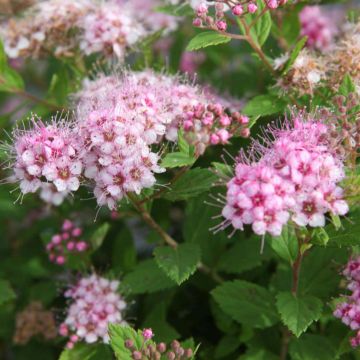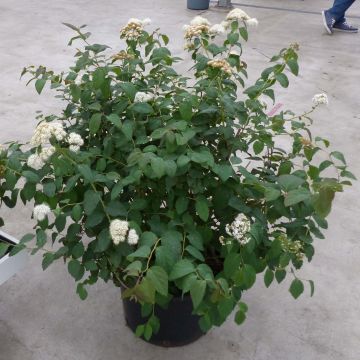

Spiraea prunifolia


Spiraea prunifolia


Spiraea prunifolia
Spiraea prunifolia
Spiraea prunifolia
Bridal Wreath Spirea, Bridalwreath Spiraea
The spirea looks in shape. It's producing new leaves. I'm waiting until May to plant the young plant in the partially shaded hedge, next to the Hay rose.
Chenapouille, 10/04/2022
Special offer!
Receive a €20 voucher for any order over €90 (excluding delivery costs, credit notes, and plastic-free options)!
1- Add your favorite plants to your cart.
2- Once you have reached €90, confirm your order (you can even choose the delivery date!).
3- As soon as your order is shipped, you will receive an email containing your voucher code, valid for 3 months (90 days).
Your voucher is unique and can only be used once, for any order with a minimum value of €20, excluding delivery costs.
Can be combined with other current offers, non-divisible and non-refundable.
Home or relay delivery (depending on size and destination)
Schedule delivery date,
and select date in basket
This plant carries a 24 months recovery warranty
More information
We guarantee the quality of our plants for a full growing cycle, and will replace at our expense any plant that fails to recover under normal climatic and planting conditions.

Would this plant suit my garden?
Set up your Plantfit profile →
Description
The Spiraea prunifolia, also known as the Plum-leaved Spirea, or more rarely the Prune-leaved Spirea, is a little-known bush to gardeners, despite the early and refined nature of its snowy flowering. Beneath its white cloud-like appearance made up of tiny pompons, lies a remarkably robust bush: neither cold, nor dryness, nor poor soils seem to overcome this indomitable spirea, which spreads - moderately - over the years. Superb in spring, it delights the gardener again with its beautiful autumn colours. For those who have planted it, there are few shrubs as endearing. Plant it in large shrub beds or in a small hedge.
The Spiraea prunifolia belongs to the Rosaceae family. It is a deciduous bush with slight suckering habit, native to China, Korea, and Japan. In the wild, it is found in thickets, on rocky slopes or steep cliffs, as well as in various dry and sunny habitats, up to 1500 m (4921ft) in altitude. Very accommodating, the only thing this plant does not tolerate is excessive limestone in the soil.
It is a bush with a bushy habit and a slightly dishevelled silhouette, supported by long and slender upright and slightly twisted branches, of a brown-red colour. It grows rapidly, reaching an average of 1.50 m (5ft) in all directions within 3 to 4 years. The flowering, which is very abundant, usually takes place in April-May, sometimes as early as March in mild climates. The tiny double white flowers, measuring 1 cm (1in), are grouped in small umbels and appear along the previous year's branches. Spiraea prunifolia develops its foliage after flowering. It is bright green in colour and often takes on beautiful red and orange hues in autumn before falling, depending on the climate and the year. The small leaves are ovate and pointed at their tips, measuring 2 to 3 cm (1in). They are alternately arranged on the branches. This spirea produces suckers at the periphery of its stump: they can be removed to limit its spread, but they can also be replanted elsewhere or offered to a gardening friend.
Hardy, undemanding, requiring very little maintenance, this lovely white spirea adapts to all climates. It can be used in beds, as a standalone specimen, in groups, and in small flowering hedges. To create a small spring flower bed that is light and airy, it can be paired with Berberis thunbergii Rose Glow, Prunus triloba multiplex, Prunus x cistena, Japanese quince, Ribes sanguineum, and white, pink, orange, or even red Cytisus x praecox, which are also undemanding plants. In a small garden, this poetic shrub has a striking presence when planted in groups of 3 as a standalone feature in the corner of a lawn.
Spiraea prunifolia in pictures






Plant habit
Flowering
Foliage
Botanical data
Spiraea
prunifolia
Rosaceae
Bridal Wreath Spirea, Bridalwreath Spiraea
China
Other Spiraea
View all →Planting and care
Plant Spiraea prunifolia in well-drained soil without excessive lime, which can cause its leaves to turn yellow (a little lime is tolerated). The soil should still be sufficiently deep, especially in dry soil in the summer. This low-maintenance bush will thrive in full sun or partial shade. To maintain the vigour of the young plant, it is vital to remove old branches at the base in spring. Light pruning may be necessary after flowering, removing half of the length from faded shoots. This plant flowers on the previous year's branches. Apply a complete fertiliser every year in March. Water regularly to aid establishment, especially in dry and hot weather during summer. Once well established (after 2 to 4 years), this spirea will manage on its own and will not require watering. It has excellent cold resistance and few enemies in the garden, except for a few aphids. In a natural garden without chemical treatments, aphids do not cause significant damage as natural predators such as ladybirds and hoverflies will control them.
Planting period
Intended location
Care
Planting & care advice
-
, onOrder confirmed
Reply from on Promesse de fleurs
Similar products
Haven't found what you were looking for?
Hardiness is the lowest winter temperature a plant can endure without suffering serious damage or even dying. However, hardiness is affected by location (a sheltered area, such as a patio), protection (winter cover) and soil type (hardiness is improved by well-drained soil).

Photo Sharing Terms & Conditions
In order to encourage gardeners to interact and share their experiences, Promesse de fleurs offers various media enabling content to be uploaded onto its Site - in particular via the ‘Photo sharing’ module.
The User agrees to refrain from:
- Posting any content that is illegal, prejudicial, insulting, racist, inciteful to hatred, revisionist, contrary to public decency, that infringes on privacy or on the privacy rights of third parties, in particular the publicity rights of persons and goods, intellectual property rights, or the right to privacy.
- Submitting content on behalf of a third party;
- Impersonate the identity of a third party and/or publish any personal information about a third party;
In general, the User undertakes to refrain from any unethical behaviour.
All Content (in particular text, comments, files, images, photos, videos, creative works, etc.), which may be subject to property or intellectual property rights, image or other private rights, shall remain the property of the User, subject to the limited rights granted by the terms of the licence granted by Promesse de fleurs as stated below. Users are at liberty to publish or not to publish such Content on the Site, notably via the ‘Photo Sharing’ facility, and accept that this Content shall be made public and freely accessible, notably on the Internet.
Users further acknowledge, undertake to have ,and guarantee that they hold all necessary rights and permissions to publish such material on the Site, in particular with regard to the legislation in force pertaining to any privacy, property, intellectual property, image, or contractual rights, or rights of any other nature. By publishing such Content on the Site, Users acknowledge accepting full liability as publishers of the Content within the meaning of the law, and grant Promesse de fleurs, free of charge, an inclusive, worldwide licence for the said Content for the entire duration of its publication, including all reproduction, representation, up/downloading, displaying, performing, transmission, and storage rights.
Users also grant permission for their name to be linked to the Content and accept that this link may not always be made available.
By engaging in posting material, Users consent to their Content becoming automatically accessible on the Internet, in particular on other sites and/or blogs and/or web pages of the Promesse de fleurs site, including in particular social pages and the Promesse de fleurs catalogue.
Users may secure the removal of entrusted content free of charge by issuing a simple request via our contact form.
The flowering period indicated on our website applies to countries and regions located in USDA zone 8 (France, the United Kingdom, Ireland, the Netherlands, etc.)
It will vary according to where you live:
- In zones 9 to 10 (Italy, Spain, Greece, etc.), flowering will occur about 2 to 4 weeks earlier.
- In zones 6 to 7 (Germany, Poland, Slovenia, and lower mountainous regions), flowering will be delayed by 2 to 3 weeks.
- In zone 5 (Central Europe, Scandinavia), blooming will be delayed by 3 to 5 weeks.
In temperate climates, pruning of spring-flowering shrubs (forsythia, spireas, etc.) should be done just after flowering.
Pruning of summer-flowering shrubs (Indian Lilac, Perovskia, etc.) can be done in winter or spring.
In cold regions as well as with frost-sensitive plants, avoid pruning too early when severe frosts may still occur.
The planting period indicated on our website applies to countries and regions located in USDA zone 8 (France, United Kingdom, Ireland, Netherlands).
It will vary according to where you live:
- In Mediterranean zones (Marseille, Madrid, Milan, etc.), autumn and winter are the best planting periods.
- In continental zones (Strasbourg, Munich, Vienna, etc.), delay planting by 2 to 3 weeks in spring and bring it forward by 2 to 4 weeks in autumn.
- In mountainous regions (the Alps, Pyrenees, Carpathians, etc.), it is best to plant in late spring (May-June) or late summer (August-September).
The harvesting period indicated on our website applies to countries and regions in USDA zone 8 (France, England, Ireland, the Netherlands).
In colder areas (Scandinavia, Poland, Austria...) fruit and vegetable harvests are likely to be delayed by 3-4 weeks.
In warmer areas (Italy, Spain, Greece, etc.), harvesting will probably take place earlier, depending on weather conditions.
The sowing periods indicated on our website apply to countries and regions within USDA Zone 8 (France, UK, Ireland, Netherlands).
In colder areas (Scandinavia, Poland, Austria...), delay any outdoor sowing by 3-4 weeks, or sow under glass.
In warmer climes (Italy, Spain, Greece, etc.), bring outdoor sowing forward by a few weeks.



























































